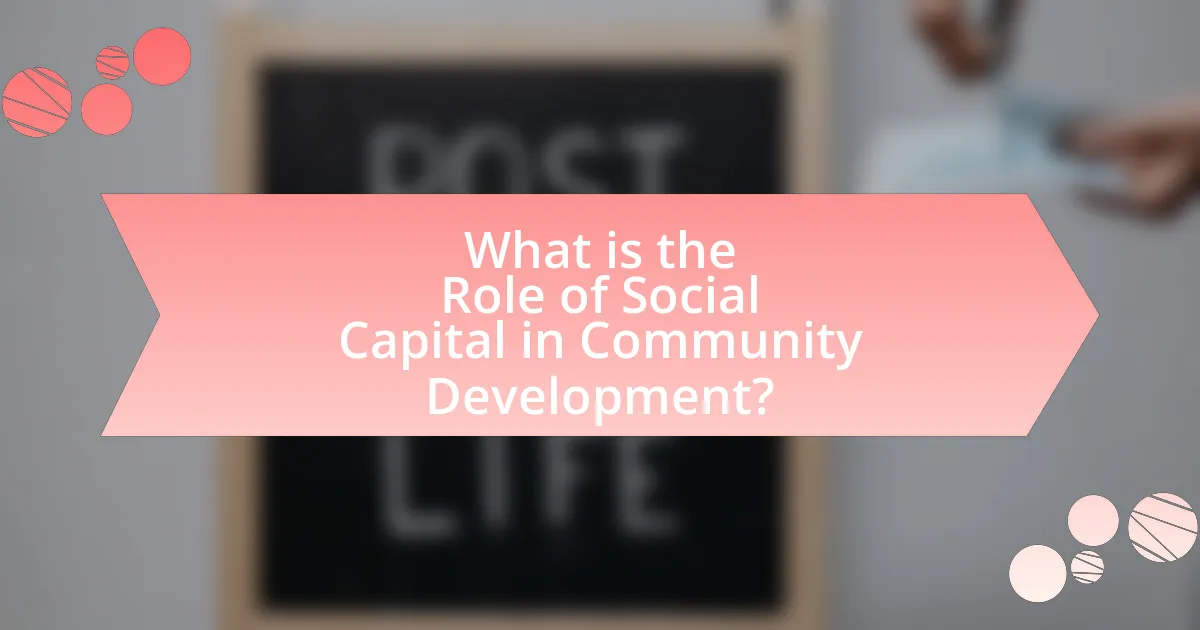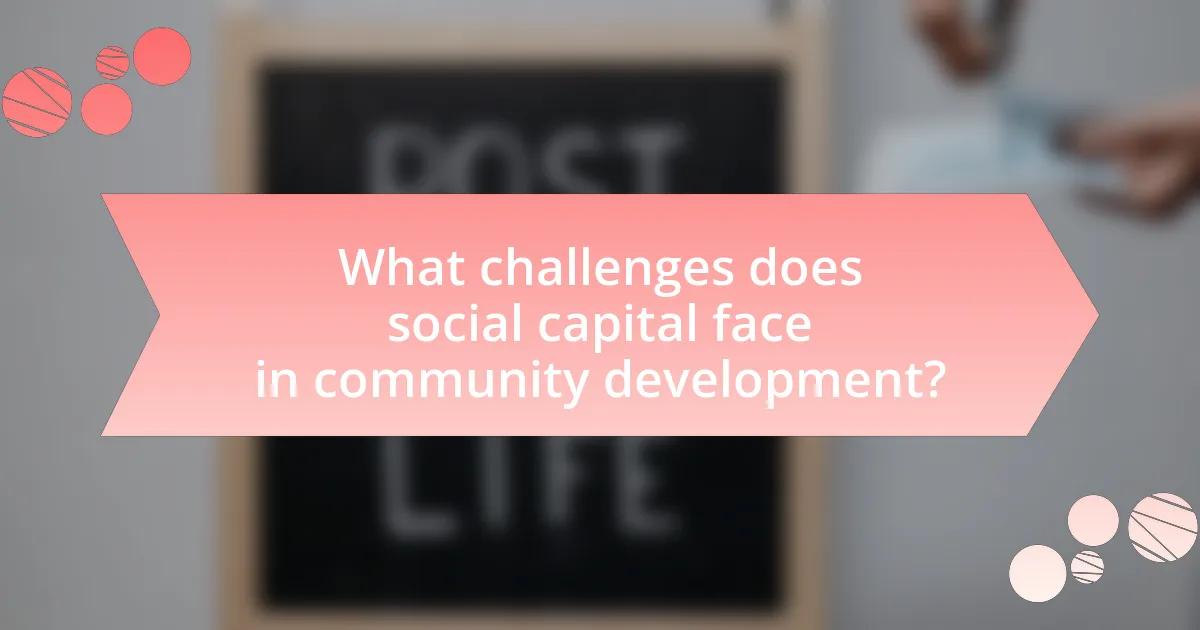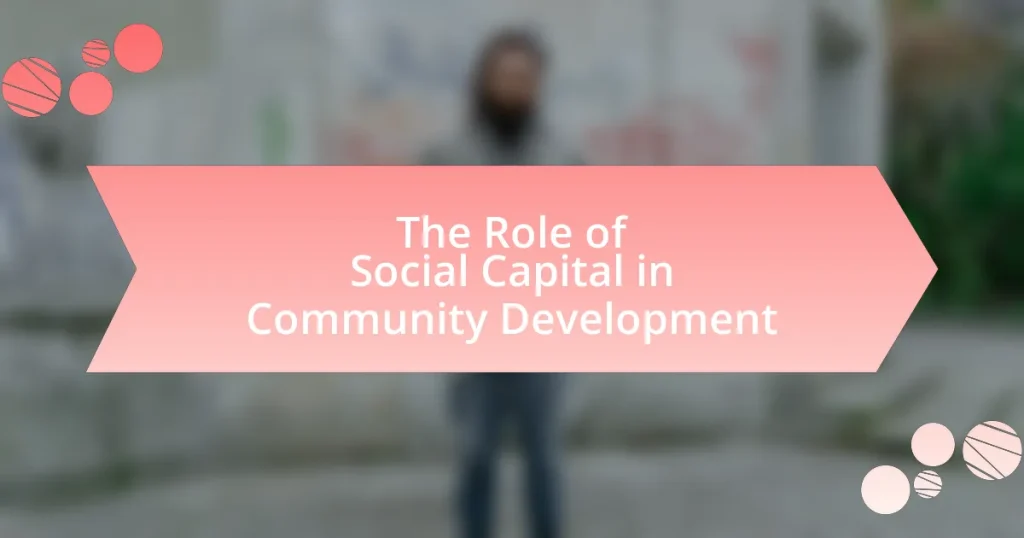Social capital is defined as the networks, relationships, and norms that facilitate collective action and cooperation among community members, playing a vital role in community development. The article explores how social capital fosters trust, enhances civic engagement, and improves economic outcomes, highlighting its key components: trust, networks, and norms. It differentiates social capital from other forms of capital, discusses its impact on community resilience and economic development, and identifies challenges such as inequality and declining trust. Additionally, the article outlines strategies for building social capital, including community events and the use of technology, emphasizing the importance of inclusive participation and collaboration in enhancing community ties.

What is the Role of Social Capital in Community Development?
Social capital plays a crucial role in community development by fostering trust, cooperation, and social networks among individuals. These elements enhance collective action, enabling communities to address common challenges effectively. Research indicates that communities with high social capital experience improved economic outcomes, increased civic engagement, and better overall well-being. For instance, a study by Putnam in “Bowling Alone” highlights that social networks contribute to economic prosperity and civic participation, demonstrating that communities with strong social ties are more resilient and capable of mobilizing resources for development initiatives.
How is social capital defined in the context of community development?
Social capital in the context of community development is defined as the networks, relationships, and norms that facilitate collective action and cooperation among community members. This concept emphasizes the importance of social interactions and trust in fostering community engagement, enhancing social cohesion, and enabling effective collaboration for addressing local issues. Research by Putnam (1993) in “Bowling Alone” highlights that communities with high social capital tend to have better governance, improved public health outcomes, and increased economic prosperity, demonstrating the critical role of social capital in driving successful community development initiatives.
What are the key components of social capital?
The key components of social capital are trust, networks, and norms. Trust facilitates cooperation among individuals, enabling them to work together effectively. Networks refer to the connections and relationships that individuals have within their communities, which can provide access to resources and information. Norms are the shared expectations and rules that guide behavior within a group, promoting social cohesion and collective action. These components collectively enhance community development by fostering collaboration and resource sharing, as evidenced by studies showing that communities with high social capital experience better economic outcomes and improved quality of life.
How does social capital differ from other forms of capital?
Social capital differs from other forms of capital, such as economic or human capital, in that it is based on the networks, relationships, and social interactions among individuals and groups. While economic capital refers to financial resources and human capital pertains to individual skills and knowledge, social capital emphasizes the value derived from social connections and trust within a community. Research by Putnam in “Bowling Alone” highlights that communities with high social capital experience better governance, lower crime rates, and improved economic performance, demonstrating the unique impact of social relationships on community development.
Why is social capital important for community development?
Social capital is important for community development because it fosters trust, cooperation, and social networks among individuals, which are essential for collective action and resource sharing. Communities with high social capital tend to have better access to information, increased civic engagement, and enhanced problem-solving capabilities. Research indicates that neighborhoods with strong social ties experience lower crime rates and improved economic outcomes, as evidenced by a study published in the American Journal of Sociology, which found that social networks significantly influence local economic development and community resilience.
What benefits does social capital provide to communities?
Social capital provides numerous benefits to communities, including enhanced social cohesion, improved economic outcomes, and increased civic engagement. Enhanced social cohesion fosters trust and collaboration among community members, leading to stronger relationships and support networks. Improved economic outcomes are evidenced by studies showing that communities with high social capital experience lower unemployment rates and greater economic resilience. Increased civic engagement is reflected in higher participation rates in local governance and community initiatives, which contribute to more responsive and effective decision-making processes. These benefits collectively strengthen community development and contribute to overall societal well-being.
How does social capital influence community resilience?
Social capital significantly enhances community resilience by fostering trust, cooperation, and networks among community members. These social connections enable communities to mobilize resources effectively during crises, facilitating quicker recovery and adaptation. For instance, research by the World Bank indicates that communities with high levels of social capital are better equipped to respond to natural disasters, as they can rely on established relationships for support and information sharing. This interconnectedness not only aids in immediate recovery efforts but also strengthens long-term resilience by promoting collective action and shared responsibility.
What are the different types of social capital?
The different types of social capital are bonding social capital, bridging social capital, and linking social capital. Bonding social capital refers to the relationships and networks among individuals within a close-knit group, such as family and close friends, which provide emotional support and a sense of belonging. Bridging social capital connects individuals from diverse social groups, facilitating access to broader resources and information, often seen in community organizations or networks that span different demographics. Linking social capital involves relationships between individuals and institutions, enabling access to power and resources, such as connections with government agencies or organizations that can influence policy. These distinctions are supported by research from scholars like Robert Putnam, who emphasized the importance of these types in fostering community engagement and development.
How do bonding and bridging social capital differ?
Bonding social capital refers to the relationships and networks formed among individuals within a close-knit group, such as family and close friends, fostering strong ties and mutual support. In contrast, bridging social capital encompasses connections that extend beyond these close groups, linking individuals from diverse backgrounds and fostering broader social networks. Research by Putnam in “Bowling Alone” highlights that bonding social capital strengthens community cohesion, while bridging social capital enhances access to resources and information across different social groups.
What role does linking social capital play in community development?
Linking social capital plays a crucial role in community development by facilitating connections between individuals and institutions across different social strata. This type of social capital enables communities to access resources, information, and opportunities that may not be available within their immediate social networks. For instance, research indicates that communities with strong linking social capital can better mobilize funding and support from external organizations, leading to enhanced economic development and improved social services. A study by Woolcock and Narayan (2000) highlights that linking social capital is essential for fostering partnerships that drive collective action and resource sharing, ultimately contributing to sustainable community growth.

How does social capital facilitate community engagement?
Social capital facilitates community engagement by fostering trust, networks, and norms that encourage collective action. When individuals within a community build relationships and establish trust, they are more likely to collaborate on initiatives, participate in local governance, and support one another. Research indicates that communities with high levels of social capital experience increased civic participation; for instance, a study by Putnam in “Bowling Alone” highlights that social networks enhance community involvement and lead to better outcomes in public projects. Thus, social capital serves as a crucial mechanism for mobilizing community members towards shared goals and enhancing overall community cohesion.
What strategies can communities use to build social capital?
Communities can build social capital by fostering strong relationships through organized events, collaborative projects, and inclusive networks. These strategies encourage interaction among residents, which enhances trust and cooperation. For instance, community events like festivals or clean-up days promote social ties and shared experiences, leading to increased civic engagement. Research indicates that neighborhoods with active social networks experience lower crime rates and improved public health outcomes, demonstrating the tangible benefits of social capital in community development.
How can local organizations foster social networks?
Local organizations can foster social networks by creating inclusive community events that encourage interaction among residents. These events, such as workshops, festivals, and volunteer opportunities, provide platforms for individuals to connect, share experiences, and build relationships. Research indicates that community engagement activities significantly enhance social capital, as they facilitate trust and collaboration among participants. For instance, a study by the National Institute of Health found that neighborhoods with active community organizations report higher levels of social cohesion and support networks. By prioritizing accessibility and diversity in their programming, local organizations can effectively strengthen social ties within the community.
What role do community events play in enhancing social capital?
Community events play a crucial role in enhancing social capital by fostering connections among individuals and building trust within communities. These events create opportunities for social interaction, allowing participants to form relationships and networks that strengthen community ties. Research indicates that communities with higher social capital experience increased civic engagement and collaboration, which are essential for effective community development. For instance, a study by Putnam in “Bowling Alone” highlights that participation in community activities correlates with greater trust and cooperation among residents, ultimately leading to improved community outcomes.
How does social capital impact economic development?
Social capital significantly impacts economic development by fostering trust, cooperation, and networks among individuals and communities. These social connections enhance collective action, leading to improved access to resources, information, and opportunities for economic activities. For instance, regions with high social capital often experience increased entrepreneurship, as individuals are more likely to collaborate and share knowledge, which can lead to innovation and job creation. Research by Putnam (1993) in “Bowling Alone” illustrates that communities with strong social networks tend to have better economic performance, as social capital facilitates the flow of information and reduces transaction costs. Thus, the presence of social capital is crucial for driving sustainable economic growth and development.
What is the relationship between social capital and local entrepreneurship?
Social capital significantly influences local entrepreneurship by fostering trust, networks, and shared norms within communities. This social cohesion enables entrepreneurs to access resources, information, and support, which are crucial for business success. For instance, research by Putnam (2000) in “Bowling Alone” highlights that communities with high social capital experience greater economic growth due to enhanced collaboration and innovation among local businesses. Additionally, a study by Aldrich and Cliff (2003) in “The Pivotal Role of Social Capital in Entrepreneurial Success” demonstrates that entrepreneurs with strong social networks are more likely to secure funding and mentorship, further validating the positive relationship between social capital and local entrepreneurship.
How can social capital contribute to job creation in communities?
Social capital contributes to job creation in communities by fostering networks of relationships that facilitate collaboration and resource sharing. These networks enable individuals and organizations to access job opportunities, share information about employment openings, and provide support for entrepreneurial ventures. For instance, communities with strong social ties often see higher rates of business startups, as individuals are more likely to collaborate and pool resources. Research by the World Bank indicates that social capital can enhance economic performance by up to 20%, demonstrating its significant impact on job creation.

What challenges does social capital face in community development?
Social capital faces several challenges in community development, including inequality in access, fragmentation of networks, and declining trust. Inequality in access to social capital can lead to disparities in community engagement, where marginalized groups may lack the connections necessary for participation. Fragmentation of networks occurs when communities become divided along social, economic, or political lines, hindering collaboration and resource sharing. Additionally, declining trust in institutions and among community members can weaken social ties, making it difficult to mobilize collective action. These challenges are supported by research indicating that social cohesion is essential for effective community development, as highlighted in studies by Putnam (2000) and Woolcock (2001).
What barriers hinder the development of social capital?
Barriers that hinder the development of social capital include socioeconomic disparities, lack of trust, and insufficient communication networks. Socioeconomic disparities create divisions among community members, limiting interactions and collaboration. Lack of trust, often stemming from historical grievances or negative experiences, prevents individuals from forming connections and engaging in collective activities. Insufficient communication networks restrict the flow of information and resources, making it difficult for individuals to connect and build relationships. These barriers collectively impede the formation of social capital, which is essential for fostering community development and resilience.
How do socioeconomic factors affect social capital?
Socioeconomic factors significantly influence social capital by shaping individuals’ access to resources, networks, and opportunities for community engagement. Higher socioeconomic status often correlates with increased social capital, as individuals with more financial resources can participate in community activities, join organizations, and build relationships that enhance trust and cooperation. Conversely, lower socioeconomic status may limit access to such opportunities, resulting in weaker social networks and diminished community involvement. Research indicates that communities with higher levels of income and education tend to exhibit stronger social cohesion and trust, which are critical components of social capital. For example, a study by Putnam in “Bowling Alone” highlights that areas with greater economic prosperity foster more robust civic engagement and social networks, demonstrating the direct link between socioeconomic factors and social capital.
What role does trust play in the sustainability of social capital?
Trust is fundamental to the sustainability of social capital, as it fosters cooperation and strengthens relationships within communities. When individuals trust one another, they are more likely to engage in collaborative efforts, share resources, and support collective goals, which are essential components of social capital. Research indicates that communities with high levels of trust experience greater social cohesion and resilience, enabling them to effectively address challenges and adapt to changes. For instance, a study by Putnam (2000) in “Bowling Alone” highlights that trust enhances civic engagement and participation, which are critical for maintaining social networks and community development. Thus, trust not only underpins social interactions but also ensures the longevity and effectiveness of social capital in fostering community growth and stability.
How can communities overcome challenges related to social capital?
Communities can overcome challenges related to social capital by fostering inclusive networks and enhancing trust among members. Building strong relationships through community events, local organizations, and collaborative projects encourages participation and strengthens social ties. Research indicates that communities with higher levels of social capital experience improved economic outcomes and resilience in times of crisis, as evidenced by studies showing that neighborhoods with active social networks recover more quickly from disasters. By prioritizing communication and engagement, communities can effectively address social capital deficits and create a supportive environment for all members.
What best practices can enhance social capital in diverse communities?
Best practices that can enhance social capital in diverse communities include fostering inclusive participation, promoting intergroup dialogue, and supporting community-led initiatives. Inclusive participation ensures that all community members, regardless of background, have a voice in decision-making processes, which builds trust and collaboration. Promoting intergroup dialogue encourages understanding and respect among different cultural groups, reducing prejudice and fostering relationships. Supporting community-led initiatives empowers residents to take ownership of their environment, leading to stronger networks and increased civic engagement. Research indicates that communities with high social capital experience better economic outcomes and improved quality of life, as evidenced by studies from the World Bank and the Pew Research Center.
How can technology be leveraged to strengthen social networks?
Technology can be leveraged to strengthen social networks by facilitating communication, enhancing collaboration, and providing platforms for community engagement. Social media platforms, for instance, allow individuals to connect and share information instantly, fostering relationships and support networks. According to a Pew Research Center study, 69% of adults in the U.S. use social media, which highlights its role in maintaining connections and building community ties. Additionally, tools like video conferencing and collaborative software enable groups to work together effectively, regardless of geographical barriers, thus enhancing social capital within communities.
What practical steps can communities take to enhance social capital?
Communities can enhance social capital by fostering inclusive social networks and encouraging civic engagement. Establishing community events, such as neighborhood gatherings or volunteer opportunities, promotes interaction among residents, which strengthens relationships and trust. Research indicates that communities with higher levels of social capital experience improved economic outcomes and better public health, as seen in the work of Putnam (2000) in “Bowling Alone,” where he highlights the correlation between social networks and community well-being. Additionally, creating platforms for dialogue, such as town hall meetings, allows residents to voice concerns and collaborate on solutions, further solidifying community ties.
